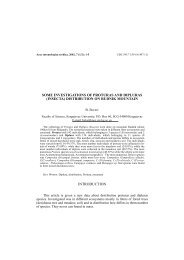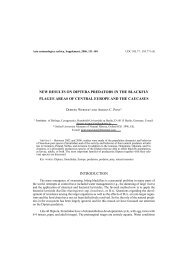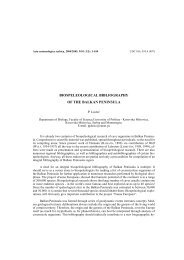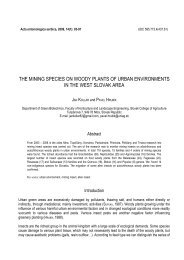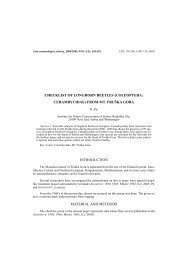Ćetković, A., Mokrousov, M., Plećaš, M., Bogusch, P., Antić, D ...
Ćetković, A., Mokrousov, M., Plećaš, M., Bogusch, P., Antić, D ...
Ćetković, A., Mokrousov, M., Plećaš, M., Bogusch, P., Antić, D ...
You also want an ePaper? Increase the reach of your titles
YUMPU automatically turns print PDFs into web optimized ePapers that Google loves.
104 A. ĆETKOVIĆ et al.<br />
1,700 km aerial distance from the closest known area of the xanthic S. deforme (SW Balkan), and about<br />
1,300-1,400 km from the much darker Nizhegorodsky populations. Hypothetically, the obvious resemblance<br />
in colour pattern suggests the Balkan stock as a probable source of this spreading. However, in such<br />
considerations, due care should be taken as to the possible environmental influence on the colour pattern<br />
variability, which is not well studied in any part of the species range – native or allochtonous (as elaborated<br />
in: ĆETKOVIĆ et al., unpublished). The area of the second putative S. deforme record (in Saratovskaya<br />
Oblast) lies about 1,000 km north/northeast from Sochi, and about 400 km south/southeast from the closest<br />
Nizhegorodsky/Mordovian records (Figs. 1 & 3); hence, also hypothetically (i.e. if we correctly identified this<br />
darker specimen), its arrival is more likely derived from the southward expanding Nizhegorodsky stock. In<br />
any case, it is least likely that additional introduction(s) into southern/eastern European Russia happened<br />
directly from Asia.<br />
These speculative considerations emphasise a need for more exact and detailed evidence to establish<br />
accurately and further track the ongoing processes of S. deforme spreading in southeastern Europe and<br />
Russia.<br />
Sceliphron curvatum: Review of distribution and spreading<br />
The native range of this species extends from Iraq to northern India and Nepal, and from Pakistan to<br />
Kyrgyzstan and eastern Uzbekistan (HENSEN, 1987; SCHMID-EGGER, 2005; PULAWSKI, 2011). The first<br />
appearance of S. curvatum in Europe was documented in southeast Austria in 1979 (VAN DER VECHT, 1984),<br />
and since the mid 1990’s, a quite rapid expansion of its allochtonous range has been recorded throughout<br />
Europe (detailed reviews in: SCHMID-EGGER, 2005; BITSCH & BARBIER, 2006). The published chronology of its<br />
spreading in southeastern Europe includes: Slovenia in 1991/1992 (GOGALA, 1995), southwestern Hungary in<br />
1995 (JÓZAN, 1998), westernmost Croatia in 1996 (GUSENLEITNER, 1996; STRAKA et al., 2004), northern<br />
Serbia in 1997 (ĆETKOVIĆ et al., 2004), central Bulgaria in 1997 (JACOBS, 2005; SCHMID-EGGER, 2005),<br />
coastal Montenegro in 1998 (ĆETKOVIĆ et al., 2004), central (coastal) Greece in 2001 (SCHMID-EGGER, 2005;<br />
STANDFUSS & STANDFUSS, 2006), and finally Romania in 2008 (“COSMLN”, 2008).<br />
Parallel with its spreading in the southeast of Europe, the species had a rapid range extension in other<br />
directions as well, so that its currently established range limits encompass: southern Sardinia by 1996<br />
(PAGLIANO et al., 2000), central Italy by 1998 (PAGLIANO et al., 2000), southeastern France by 1998 (GONSETH<br />
et al., 2001), the Balearic Islands by 2008 (CASTRO, 2010), southern Spain by 2009 (LÓPEZ-VILLALTA, 2009;<br />
CASTRO, 2010), central Spain by 2000 (GAYUBO & IZQUIERDO, 2006; CASTRO, 2007), southwestern and<br />
northwestern France by 2010 (BARBIER, 2011), The Netherlands by 2006 (VAN DER POST, 2007),<br />
NW Germany by 2004 (JACOBI, 2005a), NE Germany by 2009 (OHL, 2010), Czech Republic by 2001<br />
(BOGUSCH et al., 2004; STRAKA et al., 2004), southern Poland by 2009 (BURY et al., 2010), northeastern<br />
Ukraine by 1999 (SHORENKO, 2004), southwestern Russia by 2007 (PROKOFIEV & SKOMOROKHOV, 2010), and<br />
finally, the easternmost points in its European range by 2010: in southeastern European Russia (BOROZNOV,<br />
2010) and Georgia/Abkhazia (this paper); also, the mentioned putative record from Voronezhskaya Oblast<br />
(“KOLLEKCIONER”, 2011), if confirmed, would represent the northernmost occurrence of this species in eastern<br />
Europe. At the beginning of this century, S. curvatum also appeared in South America, being recorded first in<br />
Argentina in 2001 (COMPAGNUCCI & ROIG ALSINA, 2008) and then in Chile in 2007 (BARRERA-MEDINA &<br />
GARCETE-BARRETT, 2008).<br />
Following the above listed set of the first country records for the area of southeast Europe, relatively few<br />
additional findings were reported from the Balkans, from southwest Bulgaria (LJUBOMIROV, 2006; GUÉORGUIEV<br />
& LJUBOMIROV, 2009; BOCH, 2009), western Croatia (JÓZAN, 2009) and Romania (“ALEXAANDRU”, 2010),



